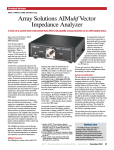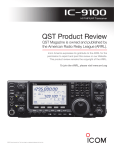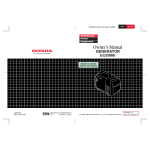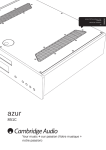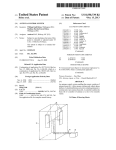Download Champion 73536i Operator`s manual
Transcript
Copyright © 2013 American Radio Relay League, Inc. - All Rights Reserved TechnicalReview Product by Mark Spencer, WA8SME Mark J. Wilson, K1RO, [email protected] A Look at Gasoline Powered Inverter Generators Portable power for your ARRL Field Day station Reviewed by Bob Allison, WB1GCM ARRL Test Engineer [email protected] The fall of 2011 was a difficult time for New England residents who experienced the effects of Tropical Storm Irene and a surprisingly heavy late October snowfall spaced a month apart. Both storms caused widespread power outages and those with backup generators maintained some comforts of normal life. My generator is an inexpensive 1000 W ac generator powered by a two stroke 63 cc engine. It’s enough to start our oil burner for heat and hot water, plus some lights and the TV. It’s not enough to run the refrigerator effectively. Generators I grew up with all ran at one speed — 3600 rpm (to produce 60 Hz) — and were noisy. Today there is a lot of interest in a type of generator that is technically advanced, more fuel efficient, lighter weight and quieter — the inverter generator. Inverter generators produce high voltage, multiphase ac that is rectified to dc — similar to an automobile alternator. This dc power is then converted back to very clean and consistent ac power by a solid state power inverter. A microprocessor controls the process as well as the speed of the engine. Unlike older constant speed generators, inverter generators can run at idle, providing power to small devices. If demand for more power appears at the generator’s outlet, engine speed increases. This feature is intended to improve fuel economy and can be switched on or off. (The various manufacturers have different names for this feature, but the concept is the same and I’ll refer to it as ECONOMY mode throughout the review.) For this review we chose four widely available inverter generators in the 2000 W class — the Champion 73536i, Generac iX2000, Honda EU2000i and Yamaha EF2000iS. All of the units were available locally from power equipment dealers, outdoor stores, industrial suppliers or box stores in the $600 to $1000 range. Prices shown in the tables are what we paid but will vary depending on dealer. Other inverter generator models are available with lower or higher power ratings. Generators in this class provide enough power for a light duty, backup power source at home or to run a power tool on the job. But how well do they work in a radio environment? All four appear to be attractive candidates for ARRL Field Day or emergency operation and so we conducted a variety of tests to determine how “radio friendly” each of these generators is. The Tests Load Test: Each generator was connected to a load consisting of two strings of incandescent light bulbs adjustable from 0 to 2500 W in 50 W steps. We measured the generator output voltage, frequency and sound level as the load increased up to the maximum rated output. In each case, the sound level was measured with a calibrated instrument at a distance of 9 meters from the muffler side of the generator. Sound levels will vary depending on location. Power per Gallon Test: Each generator was run out of fuel, refueled with precisely one cup of gasoline, then restarted and placed on a 1000 W load until it again ran dry. Running time was noted and used to calculate kilowatt hours per gallon of gas (kWh/G). Waveform Test: The Lab’s Tektronix TDS3052B storage oscilloscope captured the ac waveform during no-load and full-load conditions. Waveforms for each generator are available online.1 No-Load to Full-Load Test: Using the oscilloscope at a slow sweep speed, measurements were made at the point at which a full load was applied to the generator from a no load condition. This tough test shows how 1Additional ARRL Lab test results are available online at www.arrl.org/qst-in-depth. Bottom Line Inverter generators have advantages over normal ac generators, but have some disadvantages as well. With additional filtering, they can be made “radio friendly.” quickly a generator responds to a drastic load change with ECONOMY mode on or off. Oscilloscope plots from this test are available online (see Note 1). Conducted Emission Test: Conducted emission can have a major impact on Field Day or emergency operation as wideband RF noise is injected into the power wiring that then acts as an antenna. For our tests, we used a 100 foot extension cord. Each generator was swept for conducted emission using a Rohde & Schwarz LISN (Line Impedance Stabilization Network) and a Rohde & Schwarz EFH3 handheld spectrum analyzer.2 Radiated Emission Test: Each generator was placed on a cart and rolled around near a 40/20 meter dipole (15 feet high) to check for radiated emission from the electronics or ignition system. A nearby battery powered transceiver attached to the dipole (our simulated Field Day setup) listened for changes in noise level or ignition noise while I tuned up and down each band. The transceiver was also used for listening to conducted emissions with an extension cord plugged into a generator. Circular Saw Test: Chances are you will need a generator to power a tool. I tried to run a 15 A maximum circular saw with each generator. Safety Before operating a power generator, carefully read the operator’s manual and safety precautions. All four generator manuals recommend grounding the generator and determining local grounding codes. If you have any questions about wiring or grounding a power generator, ask a licensed electrician. I recommend using an in-line ground fault circuit interrupter (GFCI) outlet with each generator. They are available online or in most hardware stores or home centers. If you plan to use a generator during power outages at home, have an electrician install a transfer switch to isolate the generator from the power lines. 2See April 2009 QST, page 48 for an explanation of conducted emission level limits. QST – Devoted Entirely to Amateur Radio www.arrl.org June 2012 49 Copyright © 2013 American Radio Relay League, Inc. - All Rights Reserved Four Generators with a Lot in Common All four generators weigh less than 50 pounds (dry) and have a durable, brightly colored plastic shell that holds up well when bumped or scraped. All are fairly close in size, about as big as a 1980s boom box, with comfortable handles to move them about. You shouldn’t have much trouble loading any of them into your vehicle and transporting them to a portable operating location. higher speed, ready for a sudden increase in demand for power. All have single cylinder, four stroke engines and require slightly less than 1⁄2 quart of oil in the crank case. Each has a low oil level shut-off feature, a good thing for those who forget to add oil before starting for the first time or who are lax on maintenance. Each has a slightly recessed exhaust pipe, reducing the risk of painful burn blisters. Champion 73536i Each generator produces a clean, stable 60 Hz ac waveform, suitable for running radio gear, computers or other sensitive electronics. Each has two 120 V, 20 A ac outlets. All have a 12 V dc battery charging outlet, though it is for the charging of a small automotive or lawn tractor sized battery only. The 12 V dc output waveform is full of transients and is unregulated — don’t try running any 12 V device from this outlet! All but the Generac have the ability to run two identical units in parallel with an optional cable to essentially double the power capability without sacrificing portability. There is no provision for using two generators to create 240 V ac. To improve fuel economy and reduce noise when the generator is lightly loaded, each has an ECONOMY switch. With ECONOMY switched on, the generator runs at an idle speed with up to 300 W or so output. With ECONOMY off, the engine runs at a much Although the generators are similar in specifications, features and appearance, we found many differences in performance. This bright yellow and black 1700 W (2000 W surge) inverter generator reminds me of a road hazard sign. In the box I was pleased to find the manual, a container of motor oil, funnel, spark plug wrench and battery charging cable. Unlike the other three generators, round pillars dominate each corner of the plastic shell. They are designed to fit a matching generator so the two units can be stacked vertically and run in parallel. This is a smart idea that takes up less surface area and presents less of a trip hazard from the cabling. The manual is well written and has a wiring diagram, but what impressed me most was the exploded parts diagram complete with a parts list. The mechanically inclined can repair this generator at home. The Champion meets California clean air standards and gets 3 out of 10 on the green scale (0 is the cleanest). For description sake, let’s pretend this generator is an automobile, with the exhaust pipe at the back. The Champion has the controls clustered around the pull cord, on two panels on the right side. Three LEDs — a yellow OIL Champion 73536i, s/n 11MAY1801016 WARNING light, red OVERLOAD Engine: four stroke, single cylinder, 80 cc. light (lights at 1800 W threshFuel capacity: 1 gallon. old) and the green OUTPUT light AC output: 120 V at 60 Hz. — are at the top left. To the Power output: 1700 W, 2000 W surge. right of the LEDs are the DC output: 8 A at 12 V dc (battery charger). ECONOMY and engine on/off Weight: 49.2 pounds (dry). Size (HWD): 16.3 × 19.3 × 13.3 inches. switches. Below the LEDs are Price: $599 the choke knob and fuel shutoff valve. On the bottom panel, the Lab Testing: Load Test, Eco On top row has the ac outlets and a Load Output Frequency Sound Level* socket for the optional parallel (W) (V ac) (Hz) (dBa) operation cable. The bottom 0 124.5 59.9 61.0 row features outlets used during 100 124.5 59.9 61.0 parallel operation, the battery 250 124.2 59.9 62.0 500 123.6 59.9 63.5 charging outlet, dc circuit 1000 121.5 59.9 69.0 breaker and a ground terminal. On top are a vented gas cap and carrying handle. Large vents at 1500 119.9 59.9 1700 119.8 59.9 Eco off No load Fuel efficiency: 4.333 kWh/G *See text. &RQGXFWHG(PLVVLRQV4XDVL3HDN'HWHFWLRQ +RQGD &KDPSLRQ <DPDKD *HQHUDF 0DJQLWXGH>G%9@ Annoyingly for me, a lefty, all of the generators are designed to be started by a righthanded person. Fortunately, the recoil starter handle was very easy to pull on all but one of them. the front and back ends provide cooling. The left side engine access panel is secured with four screws without retaining clips so be careful if you remove them. The exhaust has a spark arrestor. 463URG5HY )UHTXHQF\>0+]@ Figure 1 — Conducted emissions from the inverter generators. 50 June 2012 ARRL – The national association for Amateur Radio www.arrl.org 72.2 73.5 66.2 Copyright © 2013 American Radio Relay League, Inc. - All Rights Reserved Testing After the usual oiling, fueling and choking, the Champion came to life on the first pull. The pull was smooth and easy. I let this generator and the others run about 15 minutes before testing. Voltage varied a reasonable 4.7 V from no-load to full-load. Response from no-load to full-load was fast with the ECONOMY switch off and took 1.5 seconds to come up to full voltage with the ECONOMY switch on (more on this type of response later). With a 2000 W load, the generator provided power for one minute before the ac switched off. The motor still runs in this condition and has to be shut off to reset the circuit breaker. As shown in Figure 1, conducted emission was quite high with RF radiated from the extension cord causing high noise levels across most of the HF bands. Ignition noise was eliminated by moving the generator 30 feet away from the antenna. The fuel economy test produced 4.333 kWh/G, the lowest of the four generators. Unfortunately, the Champion 73536i failed to run a circular saw, with the OVERLOAD light lighting and the ac shutting down in both ECONOMY modes. Generac iX2000i, s/n 6463450C Engine: four stroke, single cylinder, 127 cc. Fuel capacity: 1 gallon. AC output: 120 V at 60 Hz. Power output: 2000 W, 2200 W surge. DC output: 5 A at 12 V dc (battery charger). Weight: 49.6 pounds (dry). Size (HWD): 18 × 22 × 12 inches. Price: $589 Lab Testing: Load Test, Eco On Load Output Frequency Sound Level* (W) (V ac) (Hz) (dBa) 0 121.5 60 100 121.3 60 250 121.1 60 500 121.3 60 1000 121.2 60 1500 120.8 60 2000 120.4 60 Eco off No load 60 Fuel efficiency: 4.390 kWh/G *See text. 72.4 72.1 69.0 71.6 73.4 74.1 74.1 73.4 During the no-load to full-load test the Generac responded poorly with ECONOMY mode on or off. There was a noticeable delay before the generator got up to full voltage output. With ECONOMY mode switched on, there was a total dropout of power for a brief moment. Manufacturer: Champion Power Equipment, 10006 Santa Fe Springs Rd, Santa Fe Springs, CA 90670; tel 877-338-0999; www.championpowerequipment.com. Some good news: the conducted emission (Figure 1) was lower than the Champion or Yamaha but was still quite noticeable in the receiver. Radiated emission was stronger and the generator had to be moved 50 feet away from the test antenna for the ignition noise to subside. Generac iX2000 This orange 2000 W (2200 W surge) inverter generator has the largest displacement engine at 127 cc and can provide more power than the rest. It came with an orange funnel for adding oil, a bottle of motor oil, a two wrench set and a battery charging cable. The right side of the generator has the pull cord, fuel valve and choke control. The front end contains the control panel. At the top are a yellow LOW OIL LEVEL light, a red OVERLOAD light and a green READY light. Below the LEDs is the dc battery charger socket with circuit breaker. To the right are two ac outlets and at the bottom, the engine on/off switch and ground lug. The engine access panel is released by loosening only one screw, which has a retaining clip. At the top is a vented fuel cap that also has a little priming pump. The front and back are well vented. There was no spark arrestor at the end of the exhaust pipe. The manual didn’t indicate that this model Generac meets California emission standards. I checked the website and found this model to be compliant in 49 states. The manual is adequate but does not provide mode, the engine speed was slow to pick up as the load gradually increased. Each time a light bulb was turned on in the string, the motor speed hunted around a bit before settling down. This was by far the noisiest generator of the lot, with or without a load. During testing, it vibrated to the point where the engine access panel screw unscrewed itself. The Generac ran at its specified peak load of 2200 W for 10 seconds before shutting off both the ac and the engine. I tried but could not get the OVERLOAD LED to light before shutdown. The Generac had the lowest voltage variation between no-load and full-load conditions, only 1.1 V. a wiring diagram as found in the other manuals. Even with its larger displacement engine, fuel economy was just a bit better than the smaller 80 cc Champion engine, providing 4.390 kWh/G. The Generac iX2000 passed the circular saw test, but the saw was slow to come up to speed. You may get impatient with this generator if you have a lot of wood to cut. Testing Before I could start this unit, I had to clip off a needle-like projection on the choke control. It appeared to be an injection molding flaw with the plastic. Bandaged up and aggravated by my injury, I failed to carefully read the manual. After nearly pulling my arm off, I discovered that the engine must be primed by a pump built into the gas vent on the gas cap. Once primed, it started on the third pull. Each pull was not smooth and unlike the other generators, I could feel some compression from the piston moving in the cylinder. This red 1600 W (2000 W maximum) inverter generator carries the highest list price of the four, although we got ours from longtime QST advertiser Mayberry Enterprises for $899 including shipping. The Honda arrived with only a manual and no other accessories. The load test was interesting. In the ECONOMY The right side of the generator has the pull Manufacturer: Generac Power Systems, S45 W29290 Hwy 59, Waukesha, WI 53187; tel 888-436-3722; www.generac.com. Honda EU2000i QST – Devoted Entirely to Amateur Radio www.arrl.org June 2012 51 Copyright © 2013 American Radio Relay League, Inc. - All Rights Reserved cord, fuel valve and choke lever. Engine access is on this side as well, the cover secured by one screw with a clip. Indicators and outlets are at the front. Top row: ECONOMY mode switch, parallel operation outlets and ac outlets. Bottom row: a red OIL ALERT light, a red OVERLOAD light (lights at 2200 W threshold) and a green OUTPUT light. The OUTPUT LED also acts as a simplified run-time hour meter. It blinks once after 100 hours of operation, twice for 200 hours and so on. The front and back have large vents for cooling and there is a spark arrestor on the exhaust. This particular model does not meet California emission standards, though Honda offers a similar model available for sale in California. The manual is very good and includes everything needed to know to run and maintain the unit. Testing The Honda EU2000i started on the first pull. I found the voltage to be a bit high, 127 V ac output with a 100 W load. The voltage varied 4.6 V from no-load to full-load. With the highest loads, the Honda was quiet with very little visual vibration. The no-load to fullload response was the best of the four. I ran the Honda with a 2000 W load for its rated 30 minutes with not one hint of overheating or straining. While the Honda has levels of conducted emission as high as the other three on 160 meters, the levels drop off quickly, making this the least offending inverter generator in this department. See Figure 1. Though some noise can be heard, a receiver is usable with this generator attached to an extension cord. Ignition noise was fairly low as well. The 98.5 cc engine provided 4.480 kWh/G, number two in the fuel economy department. The Honda powered a circular saw flawlessly in both ECONOMY modes. Honda EU2000i, s/n EAAJ-2263469 Engine: four stroke, single cylinder, 98.5 cc. Fuel capacity: 0.95 gallons. AC output: 120 V at 60 Hz. Power output: 1600 W, 2000 W maximum. DC output: 8 A at 12 V dc (battery charger). Weight: 45.6 pounds (dry). Size (HWD): 16.7 × 20.2 × 11.4 inches. Price: $899 Lab Testing: Load Test, Eco On Load Output Frequency Sound Level* (W) (V ac) (Hz) (dBa) 0 127.2 59.9 100 127.0 59.9 250 126.4 59.9 500 125.7 59.9 1000 124.4 59.9 1500 123.0 59.9 1600 122.7 59.9 Eco off No load Fuel efficiency: 4.480 kWh/G *See text. 61.6 61.6 62.0 63.3 66.5 70.0 71.0 67.4 Manufacturer: American Honda Power Equipment Division, 4900 Marconi Dr, Alpharetta, GA 30005; tel 770-497-6400; powerequipment.honda.com. Yamaha EF2000iS This royal blue 1600 W (2000 W maximum) inverter generator included a manual, spark plug wrench and battery charging cable. On the right side is the control panel, arcing around the pull cord handle. At the top of the panel are a red OIL WARNING light, a green AC pilot light and a red OVERLOAD indicator. While testing, I found the OVERLOAD indicator illuminated at the 1850 W threshold. Lower on the control panel are a black ECONOMY mode switch and a red engine on/off switch. About halfway down are the fuel shutoff valve and a choke control that must be pulled out when starting the engine. Below the choke are terminals for running two generators in parallel and two ac outlets. At the bottom of the control panel are the dc receptacle, dc circuit breaker and ground terminal. At the top are a carrying handle and a vented fuel tank cap. The Yamaha is the only generator of the four with a fuel gauge, although I noticed the generator ran a long time while the gauge read E. The front and rear sides have large vents for cooling. The exhaust pipe has a spark arrestor. The left side of the unit has two screws (no retaining clips) that secure the engine access panel. The manual is clearly written with ample illustrations and instructions for servicing the generator. A wiring diagram is included. This generator meets California air pollution standards and rates 3 out of 10 on the green scale. Testing After filling the EF2000iS with oil and fuel, I pulled out the choke rod and gave it one easy, slow pull. It started! After a few seconds, I pushed the choke rod in and the Yamaha settled down into a soft purr with ECONOMY switched on. The Yamaha overall was the quietest at low rpm. No vibrations of the case were noticed, even at full load. The output varied 5 V ac from no-load to full-load — reasonable, but the most output change of the four generators. The no-load to full-load testing showed a very slow but steady response with ECONOMY mode on, but a very quick recovery with ECONOMY mode off. I placed the Yamaha on a 2000 W load. In 20 seconds, the overload circuitry kicked in and shut off the ac and the engine. Figure 1 shows the conducted emission of the Yamaha is very high all the way up through the 20 meter band. We placed the generator 100 feet away from the operating table with the extension cord running perpendicular to the test dipole antenna, which was an additional 30 feet away. On the battery powered transceiver, an S9 level of noise peaks with slightly lower levels of hash were heard across 40 meters and S8 across 20 meters — all with the generator in the ECONOMY mode, at idle. Increasing the demand increased the noise level. Clearly, there is a need for filtering at the ac outlet (more on that later). With the extension cord unplugged and the Yamaha running with the ECONOMY mode off, the radiated emission was found to be mostly from the ignition system. With the generator parked directly under the antenna (15 feet up), a few S units of ignition noise from the spark plug was observed. Turning on the receiver’s noise blanker removed all of it; moving the generator 30 feet away (off the broad side) also reduced the ignition noise to nothing. The Yamaha EF2000iS won the fuel economy test by a significant margin, creating 5.37 kWh/G. I suspect this is due to the generator’s small 79 cc displacement. The engine ramps up quickly in the no-load to full-load test, so for power tools I would leave ECONOMY mode on. 52 June 2012 ARRL – The national association for Amateur Radio www.arrl.org Copyright © 2013 American Radio Relay League, Inc. - All Rights Reserved Yamaha EF2000iS, s/n 7DK 1516423 <DPDKD()L6 &RQGXFWHG(PLVVLRQ4XDVLSHDN'HWHFWLRQ:/RDG Engine: four stroke, single cylinder, 79 cc. Fuel capacity: 1.11 gallons. AC output: 120 V at 60 Hz. Power output: 1600 W, 2000 W maximum. DC output: 8 A at 12 V dc (battery charger). Weight: 44 pounds (dry). Size (HWD): 17.9 × 13.3 × 11.0 inches. Price: $990 59.9 60.0 60.0 62.4 66.8 71.0 71.0 67.4 0DJQLWXGH>G%9@ Lab Testing: Load Test, Eco On Load Output Frequency Sound Level* (W) (V ac) (Hz) (dBa) 0 124.6 60 100 124.3 60 250 122.7 60 500 123.0 60 1000 121.5 60 1500 120.1 60 1600 119.6 60 Eco off No load Fuel efficiency: 5.347 kWh/G *See text. 1R)LOWHU :LWK&RUFRP)LOWHU &RPPRQ'LIIHUHQWLDO)LOWHU 463URG5HY Conclusions and Observations A radio amateur’s requirements for portable power are different from those of the average user. A homeowner’s generator, acting as a backup power supply, usually works with fairly static loads. Power demand usually stays at one level for a while. On the other hand, a generator used for powering an SSB, AM or CW station is faced with a dynamic load, one that changes rapidly with modulation or on/off keying. How do these generators respond to dynamic loads? )UHTXHQF\>0+]@ Figure 2 — Conducted emissions from the Yamaha EF2000iS inverter generator with no filtering (blue line), a commercial Corcom filter (green line) and a filter built in the ARRL Lab (purple line). respond, the increased load disappeared. Keying slowly, I could make all but the Generac make the sound of a grunt or laugh. Also, the line voltage would momentarily dip while keying; the Generac responded poorly to this test by speeding up and slowing down in an erratic manner. Though no chirp was detected in my test receiver, I did this test with only one transmitter. I suspect some transmitters may wobble in frequency or chirp with a momentary voltage dip. I would recommend leaving ECONOMY mode off so that the engine runs at a higher speed, ready for a momentary increase in load while transmitting. Manufacturer: Yamaha Motor Corp, 6555 Katella Ave, Cypress, CA 90630; tel 800-962-7926; www.yamaha-motor.com. An option is to use the generator to operate one or more battery chargers and run all transceivers from battery power. That way it is possible to take advantage of the ECONOMY mode, provided that the generator output is filtered, which leads me to the next topic. Conducted Emissions The biggest finding of this review is the high conducted emission levels of these inverter generators. My little 1000 W conventional ac generator has very low conducted emission levels, but the output waveform has a harmonic in it and is not nearly as clean as the inverter output. As with inverters used to generate ac from batteries, inverter generators are power generating devices and don’t plug into a wall outlet, so they are not held to FCC Part 15 conducted emission level limits. There are two ways to attack this problem — buy a commercially made filter or build one. Figure 2 shows the Yamaha’s conducted emission with no filter, with a commercially made filter made from Corcom (www.cor. com), and with a homemade filter whipped up by the ARRL Lab’s RFI expert, Mike Gruber, W1MG. Most of the conducted emissions are common mode, though some is also differential mode. The amount of each mode may vary with different model inverter generator. Mike believes with some experimentation, patience and some 2.4 inch diameter type 31 toroids (www.fair-rite. com), the owner of an inverter generator can greatly reduce the conducted emission level. More information is available online at www. arrl.org/products-and-other-information (click on AC Line Filters). Click to see an overview of four portable generators I set up a 200 W transmitter and 300 W of incandescent lighting. With ECONOMY mode on, 300 W is just below the threshold of increased engine rpm. As I keyed the transmitter, each generator would try to respond to the increased load by momentarily trying to raise its rpm. Before the engine speed could QST – Devoted Entirely to Amateur Radio www.arrl.org June 2012 53





